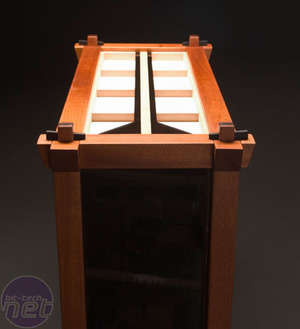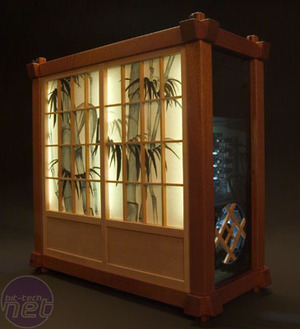Honestly, the youth of today! Answer me this much: do you remember your first case mod? If you've been in this game as long as some of us, the answer is probably a home-made window or perhaps a hand-cut blowhole, right? Fast forward to the present day and it seems growing up on a diet of Orac³ and Hypercube² mods has inspired the next generation of modders to aim high. Very high.
Enter 19-year old college student Nick Falzone. Towards the end of his freshman year studying Architecture at California Polytechnic State University in San Luis Obispo CA, Nick saw an opportunity to improve on existing wooden case mods and conceived a design inspired by Japanese lamps and shoji screens.
The fact that he had never self-built a standard PC before, let alone an ambitious case mod, clearly didn't faze him. This is the story of Sangaku, his Japanese case mod.

He decided to build a custom case that represented this understated Japanese coolness using his skills and experience with wood. It's basic dimensions would clearly define it as a PC - the goal wasn't to try to create something really crazy like the guys at WCG 2005 with Alien heads and fish tanks etc. Something aesthetically pleasing that, first and foremost, looked like some badass Japanese woodwork, but was also a PC.
The idea of naming this project Sangaku actually came from bit-tech forum member 'Axly' after Nick appealed for suggestions. That's the bit-tech community spirit at work.
Back in the 21st Century, the spirit of the ancient sangaku lives on in the craftmanship and attention to detail of this project. In the end, there are some 130 wood joints and the case took approximately 300 hours to build in Nick's spare time over nine months during 2005.


Here is a sneak peek of the final result. Keep reading for a detailed view of how it was built.
Note: This case mod was originally unveiled on ExtremeTech. We hope you enjoy the full, in-depth worklog here on bit-tech.
Enter 19-year old college student Nick Falzone. Towards the end of his freshman year studying Architecture at California Polytechnic State University in San Luis Obispo CA, Nick saw an opportunity to improve on existing wooden case mods and conceived a design inspired by Japanese lamps and shoji screens.
The fact that he had never self-built a standard PC before, let alone an ambitious case mod, clearly didn't faze him. This is the story of Sangaku, his Japanese case mod.
Design Inspiration
By his own admission, Nick is a recent convert to computer modding but he has been a furniture maker for a while. In contrast, his college roommate is the opposite, in that he knows lots about modding but not a great deal about furniture so with his help, Nick decided to combine the two and make a computer that resembles a piece of furniture.
The basic design elements of Japanese architecture, such as 'Shoji' sliding doors and
wooden ornamental lamps heavily influenced Nick's design for Sangaku
There's no doubting that, while it might seem completely normal from a Japanese perspective, for most Westerners traditional Japanese architecture has certain "cool factor" about it. Maybe it's the association with martial arts films - who knows - but as an architecture student, all the straight lines and natural wood really got Nick thinking.wooden ornamental lamps heavily influenced Nick's design for Sangaku
He decided to build a custom case that represented this understated Japanese coolness using his skills and experience with wood. It's basic dimensions would clearly define it as a PC - the goal wasn't to try to create something really crazy like the guys at WCG 2005 with Alien heads and fish tanks etc. Something aesthetically pleasing that, first and foremost, looked like some badass Japanese woodwork, but was also a PC.
Why Sangaku?
Sangaku is the Japanese word for unique, wooden, mathematical tablets created during the Edo period (1603-1867) in Japan - a period when all Western influences were shunned. In short, they involved some seriously crazy math problems which equally crazy math geeks (albeit honourable ancient Japanese samurai-type math geeks) worked on and challenged each other with. Think The Last Samurai meets A Beautiful Mind and crossed with sudoku. This site has a great explanation of the serious side to sangaku.The idea of naming this project Sangaku actually came from bit-tech forum member 'Axly' after Nick appealed for suggestions. That's the bit-tech community spirit at work.
Back in the 21st Century, the spirit of the ancient sangaku lives on in the craftmanship and attention to detail of this project. In the end, there are some 130 wood joints and the case took approximately 300 hours to build in Nick's spare time over nine months during 2005.


Here is a sneak peek of the final result. Keep reading for a detailed view of how it was built.
Note: This case mod was originally unveiled on ExtremeTech. We hope you enjoy the full, in-depth worklog here on bit-tech.

MSI MPG Velox 100R Chassis Review
October 14 2021 | 15:04









Want to comment? Please log in.